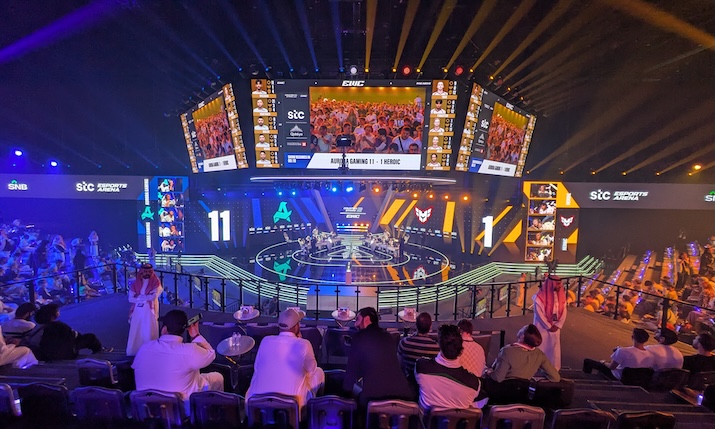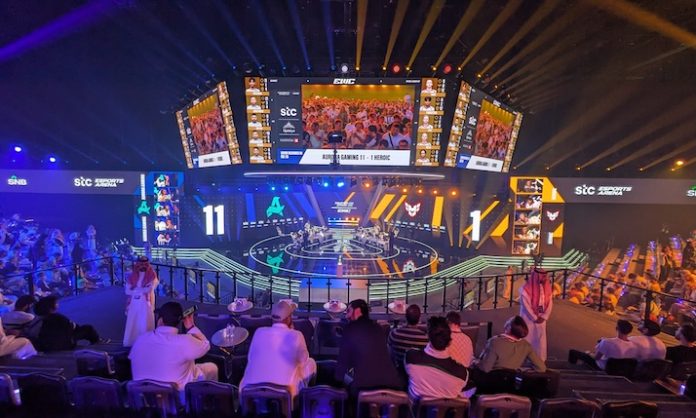
To no-one’s surprise Team Falcons has won its second consecutive Club Championships at the Esports World Cup (EWC). However, the Saudi-owned esports organisation was taken to the final week by seven other teams giving the whole tournament a competitive edge it lacked when Falcons romped to victory with weeks to spare in 2024.
Hosted for the second year in Riyadh, the seven-week long tournament, which concluded on Sunday (24 August) looks set to be not just an annual fixture on the esports calendar but a major attraction on the global sports scene. That’s the masterplan anyway.
“We’ve had decades now of esports, but it’s really been the idea of competition towards conclusion of one specific tournament,” said Mike McCabe, COO of the Esports World Cup Foundation, which is the event organiser. “The Club Championship at EWC makes it bigger. Being able to create a longer, more connected story over the course of the seven weeks is something that we’ve really leaned into and we think is truly unique. This year, having it come down to the final week and be so incredibly close amplifies the whole competition.”
EWC 2025 organised 25 video games competitions ranging from chess to 5v5 first person shooter title Valorant. All 200 clubs could field teams in every discipline with points and cash prizes going to the winners of each individual game out of a total prize pool of $70 million. The championship cumulative points total determined the winners of the Club Championship with the top 24 clubs splitting $27 million and the winner landing a $7 million pay cheque. Team Falcons were only victorious in one game (Overwatch 2) but had the strength in depth to accumulate high scoring positions in 21 other games.
“When we launched EWC in 2023 our purpose was clear from day one; to elevate esports and make it more sustainable,” said Ralf Reichert, CEO, EWC Foundation. “After just two years, the Esports World Cup is no longer a bold idea; it’s the foundation of a global sport. Within esports, EWC is the biggest so far in this industry. It’s a unique club competition featuring the best games with the world’s best athletes. What has happened at EWC 2024 and again here in 2025 is bigger than we ever imagined. And in 2026 [when EWC returns to to Riyadh from 6 July-23 August] we’ll take it even further.”
The stats speak for themselves.
EWC 2025 set new records with 750 million viewers and a peak of 7.98 million viewers during Gen.G Esports’ victory in Week 2’s League of Legends tournament. Some 340 million hours of content have been watched, outperforming 2024’s inaugural event across the board (the comparative figures for 2024 saw 250 million hours of content streamed to 500 million viewers and a peak viewership of 3.5 million).
In addition, the competition and adjacent festival of gaming featuring myriad games-related activations for the public drew more than 3 million visitors to Riyadh’s Boulevard City, topping last summer’s 2.6 million.
The effort to attract a wider audience outside the esports community was centred on EWC Spotlight, a new global broadcast production managed by IMG. In total, 7,000 hours of live content were produced (proudly proclaimed to be second only to the 2024 Paris Olympics) across more than 800 channels and 97 broadcast partners, in 35 languages.
Read more Esports World Cup: IMG puts a Spotlight on innovation as esports goes mainstream
“We have to remember that esports is very nascent,” explains Viranda Tantula, who served as executive creative director for EWC2025’s opening ceremony. “It started out being very crude and it was only when Riot Games entered the picture, 20-25 years ago, that esports coverage jumped to being well produced. Since then, there’s been a constant attempt to find the sweet spot between serving the core audience – the hardcore fan – but then also creating something that’s appealing enough to bring new people in. That’s where EWC this year is doing a pretty good job with Spotlight. For example, it introduces people new to each game with simplified heads-up displays. A little bit of simple explanation goes a long way.”
For a casual esports observer like your SVG Europe correspondent watching the game live in the arena can be confusing and not a little overwhelming. The faces of the players remain largely fixed as they concentrate on the screen in front of them and viewers can barely see their hand movements – they are after all just sitting on PC chairs playing with a console. To bulk this up as a spectacle for fans in the arena, giant LED screens display the action in incredible detail.
Each player has a OBSBOT Tail 2 POV camera trained on their face, other RF and Steadicams rove closer to them on the stage all but blocking the action for the studio audience, but their attention anyway seems fixed on the screen displaying the actual game play. For two-person games like Streetfighter, chess or games culled from conventional sport like EAFC this is relatively easy to follow, but you’d need to have played a multiplayer title like Crossfire to follow what’s going on. Data from each player’s gameplay is translated into graphics on the main screen, game commentary is broadcast in the arena along with constant kinetic show elements, special effects and high-energy music amping up the level of excitement even in clearly one-sided competitions.
The director mixing the live action for the arena displays and live stream on Twitch and YouTube can choose from a bewildering array of feeds – which could include 10 in-game virtual cameras (one per player), an overall ‘map’ for games like League of Legends or Counterstrike plus Grass Valley box cams, Steadicams (mostly Sony Venice) and wire-cams from Luna Remote Systems, including both 1-point and 4-point setups. There are also EVS XtraMotion and EVS VIA classic slow-mo systems.
“The thing that separates esports from traditional sports is that a higher percentage of the viewing audience also happens to play the game at a high skill level,” explains Tantula. “Anybody can watch basketball and go out on the blacktop and play but you’re not necessarily playing at the highest skill level. People who watch esports are used to consuming that amount of data. You will find a correlation between the people that play games and being fast at skills like maths.”

Viranda Tantula
The ability to be able to take in constantly changing data from multiple sources simultaneously and compute it to be able to react is also an attribute shared by the broadcast directors. Most of them grew up with esports and will specialise in one or more discipline so they know the game play inside and out.
“Much like in traditional sports we have broadcast directors in charge of specific cameras. They’re keeping an eye on the specific parts of the action. Those people need to simultaneously be a technical artist and a camera operator or director. They also need to be a fan of the game and an expert on the game. In games like Streetfighter this process is a little easier in terms of camera because there’s only two players and the game is a relatively fixed frame. They might want to pull out to a crowd shot from time to time or a close-up of the intense look on a player’s face but in Crossfire or CS2 you have 10 players (five a side) each with POV cameras on them and each with a different view of the game,” he says.
To optimise the broadcast of esports, producers have studied where a viewer’s eyeball goes to on screen and what data they’re trying to consume. “In the early days of esports, 20 years ago, the broadcast graphics were a bit of a mess. Now they are incredible,” he continues. “What has changed is the relationship between the game developers and the broadcast team. The heads-up display of the game itself is not going to be messed with. That has to be optimised for gameplay because that’s the core product but over time there’s been a lot more collaboration between game dev teams and the esports broadcast teams to be able to take the API from the game to pull data and pull real-time stats and translate that for broadcast.
“Even things like sponsor integration used to be very crude. It would just be a logo introduced rather clunkily on screen. Now there are really cool opportunities for sponsors to wrap something in 3D into the game itself.”
Production is organised by ESL Faceit Group (EFG), a division of esports’ event organiser ESL and a subsidiary of Savvy Games Group which is owned by the KSA’s Public Investment Fund.
EFG built four esports stages running different competitions in parallel. By numbers they consist of: 3,000+ square metres of LED, 2,600+ light fixtures, 200+ high-performance audio speakers, hundreds of kilometres of cabling and more than 1,000 crew onsite.
“Because this is such a complex project, we involved publishers right from the R&D phase,” explains Vlad Petrescu, EFG executive producer, EWC. “We studied the best esports productions globally and the unique requirements of each game to make sure we deliver top-tier results. During the live shows, we have systems in place to quickly take on and implement publisher feedback across all production lines.”
“We don’t use a facilities provider — everything is built on-premises by EFG’s engineering team,” he adds. “On a typical day, when all four main stages and three secondary stages are active, we run 18 production lines.”
All production lines are equipped with GV vision mixers, EVS for replays and playout, Lawo audio stations, and 2110 IP distribution.
“Each stage has multiple production lines that interact with one another. It starts with in-game production, which shows the match and directs the observers. Then comes stage production, which handles the stage show and big moments like player reveals. From there, our English, Arabic and Chinese teams take the feed and add localised content like match analysis and custom video assets. We use various AI tools to enhance the final product, but the main editing is still done by editors who specialise in esports content.”

The opening ceremony, which featured a performance from Post Malone, was produced by Tantula and Ariel Horn who began his career in traditional TV at NBC Sports and Olympics, working on four Olympics and Sunday Night Football.
“We aspire to be like a Super Bowl half-time show on one level, but we also understand that our audience is a bit different,” Tantula explains. “There’s a certain type of spectacle they expect. How much do we try and emulate real traditional sports and how much do we be our own thing?
“When planning the Super Bowl half-time show you’d storyboard it then shoot a rehearsal with 30 cameras then go and edit those cameras into a show. There are some benefits to that, but it’s also very cumbersome. For the opening ceremony at EWC we pre-vized our whole show in Unreal. We programmed in all of our broadcast cameras with the proper lenses. That buys a lot of efficiency with rehearsal time.”
They brought together artists Dino of Seventeen, Duckwrth and The Word Alive to write the official EWC 2025 music track, pointedly titled ‘Til My Fingers Bleed ’. The track fuses K-pop, hip-hop and rock.
“I’ve loved the genre and fandom of the K-pop world ever since my days helping bring K/DA to life, and this time we’ve collided it with metalcore and H-hop,” says Tantula. “Hopefully we understood the rules of these genres well enough to know how to break the rules.”
This is important since for all the execs at EWC, esports does not stop at video gameplay. They see a major strength of esports is its latent ability to transcend boundaries, literal and cultural.
Tantula was at Riot Games for eight years in the early days of esports helping the developer make its first forays into collaborations with the fashion industry before co-founding creative studio and consultancy Potion Projects in 2020.
“We operate at the intersection between the different verticals of gaming, music, film, art, fashion and sport,” he says. “In an increasingly global world, with everything going on, it’s easy to feel divided but these are some of the few universal languages that transcend borders. Some kid in Korea could be playing with a kid in the US and with another in the Middle East. Esports is so exciting because it connects people.”
